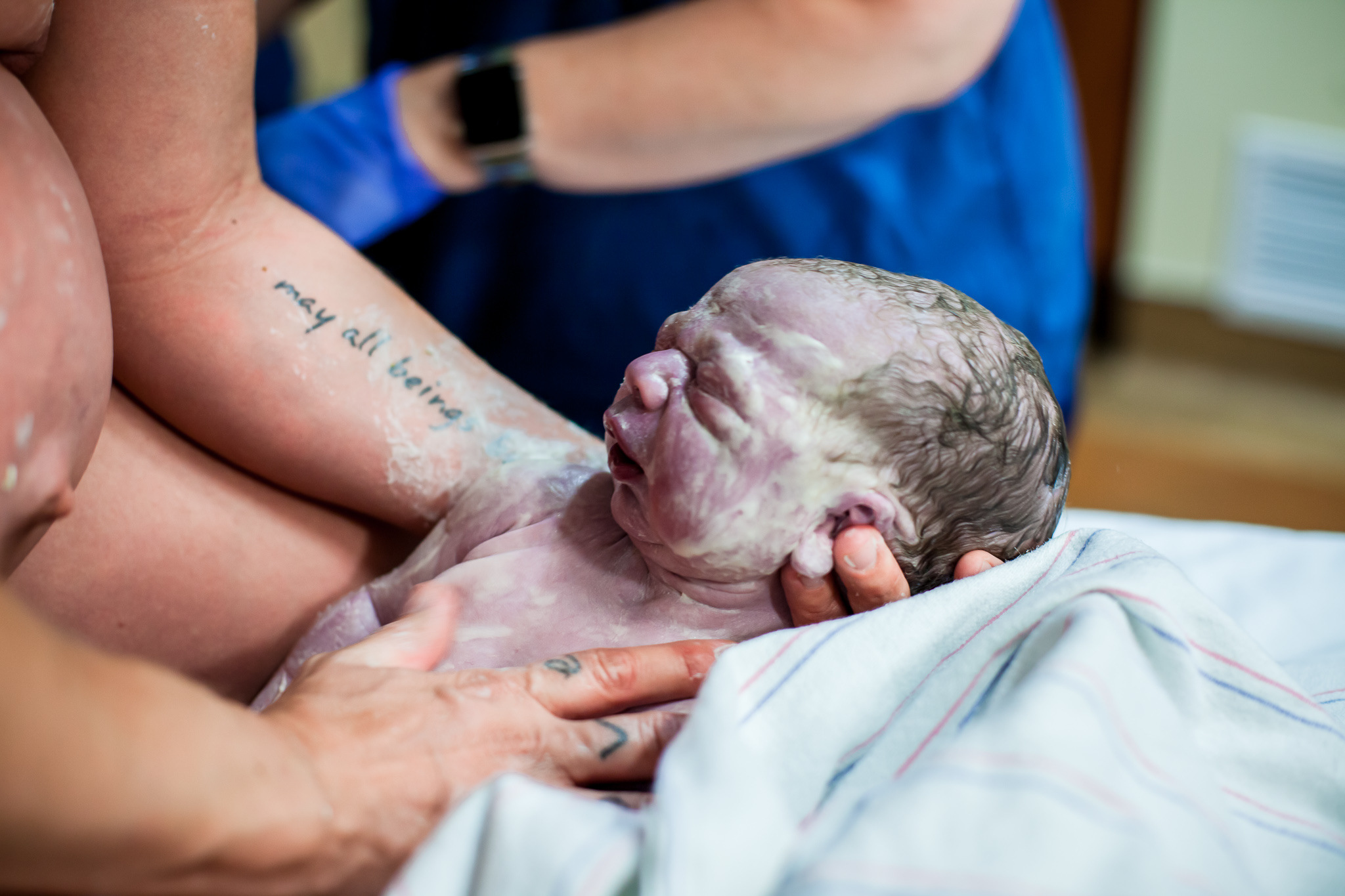In the first few hours of Helen’s 24th birthday, she called out to me from across our 750 ft2 house, “Um, Joe. Wake up. My water just broke,” her voice curling up into something like a question at the end. I shook off the deep sleep and tried to be as calm and responsible as I could in spite of my excitement.
For the next three hours, I alternated between preparing our house for the birth – blowing up the birth pool; getting towels, under-pads and candles in the right places; texting the midwives; doing leftover dishes – and watching my wife grow silent, hang on doorframes, rock uncomfortably to cope with her increasingly intense contractions.
Around 5am, I had run out of things to do and my excited expectations met up with the reality of the situation: our baby was still long in coming. With this in mind, Helen put on an episode of Joss Whedon’s Dollhouse and I went back to bed.
Helen slept in between contractions as best as she could while I, under pretense of getting sufficient rest for the hard work ahead, slept like a winter bear. But we got up at 7 and decided that we could make it through Mass. (We have been in search for a parish since we arrived in Pasadena and have yet to feel comfortable at one. This is on account of the poor music choices that seem to be the distinguishing feature of West Coast parishes. Lucky for us, the 7:30 service was entirely spoken and did not add more discomfort to Helen, who struggled enough to remain focused through the Mass.) When we got back home, we settled in to the day – the birth day.
Our street is quaint. The people who sit out on their porch are friendly and talkative. The sidewalk buckles over the roots of old oaks. We walked out before it got hot and we walked slowly down one side then up the other. When Helen had a contraction, she would get behind me and lean into my shoulders while I looked at my watch. I wondered about the people who might have seen us, or rather, me; a husband who seems to care only about keeping time.
At home, we ate some. We listened to podcasts. There was a lovely story on The Moth about a satirist who used to be a monk and about his mentor whose sense of humour preserved any hope for the satirist’s salvation. I watched her contractions. I didn’t help out too much at this point. She didn’t seem to need it. She simply grew quiet and breathed as best as she could remember.
The midwife came around 1pm to check on our – more precisely, Helen’s – progress. 2 centimetres. Nearly 12 hours of sporadic contractions for 2cm. Helen was discouraged, though the midwife and I assured her that everything was normal. But nothing is normal about this process and Helen was the only person who seemed to pick up on that. Birthing is natural, but it is not normal – it is exceptional and extra-ordinary. Despite the patterns of millennial observation that have yielded a best fit line for all pregnancies and births, it is nonsense to insist that Helen’s labour – the interruption and postponement of all other thoughts and activities so that she succeeds at bringing another person into the world safely – approximates normal.
So the midwife left with instructions to call as things progressed, which she affirmed would happen. “Get some rest. You’ve got a ways to go and you don’t want to tire yourself out,” she insisted. It was the hottest part of one of the hottest days of the year, so we decided to take her advice. We watched some TV and I watched Helen close her eyes, turn inward to the pain, and endure it. We rested very well. Too well. The contractions grew very far apart and there was no discernible pattern to them. Labour had yet to really begin.
When evening set in, we realized that so much of the irregularity and the reticence to speed things up intentionally came from Helen’s discomfort – what we did not know is that Sunday was a prelude to the hottest day of LA county’s history. The heat conquered our house, which soaked it up like a sponge and didn’t release until the middle of the night. Before we lost our minds to fever, we thought we’d call the midwife again.
She arrived, supplies in tow: big, black utility emergency chest; oxygen tank; and several other med kits. But when Helen lay down for a check, she was met with disappointing news – though mostly effaced, the cervix was still only a little more than 3cm dilated. It had been about 20 hours since Helen’s waters broke and not a lot of labour was happening, though Helen would beg to differ. “If we get to around 8am or so and you haven’t gotten past 6cm, then we’re going to have to speed things up – with Pitocin,” she informed us.
This was not good news, especially after such a discouraging day. Helen was distraught when her sister and niece arrived. She feared facing hospital procedures after the exhausting 24 hours she had been through. I assured her that we would stick to our plan – we were fully able to make this thing happen and I was going to make sure it fit what we wanted before emergency measures were taken. We made a plan: we’ll sleep as best – or as much – as we could, get up at the 24 hour mark, start taking proactive measures (nipple stimulation, duck walking, homeopathic remedies, a tincture of blue cohosh to increase the intensity of contractions), and then hopefully we’ll be much farther along well before the 8am deadline.
It was like deja vu; Helen woke me up at 2am, like the night before, in the middle of a contraction and I jumped out of bed to be at her side. “Would you make your hard drive stop making that awful noise?!” She had been awake for about two hours and started activating labour as we had planned.
It was working.
When the midwife arrived at 3:30AM, Monday morning, Helen was silently begging for good news. Let this not have been in vain.
“Oh my, your cervix is … I can hardly feel it, it’s paper thin,” she said. She moved around some more with that far off look, as if somehow her eyes were in her fingers. “Yup, 7cm. For sure.” I think I grinned – we were well on our way this time. No more uncertainty. This provided a lot of energy for me and I know Helen’s spirits were uplifted. What I found most interesting about the labour is that Helen pushed away all of her knowledge so that she could focus entirely on what her body was doing: she knew what happened in each stage and what to expect.
So I thought. In fact, Helen was overtaken by the work her body was doing that all that mattered was seeing that it was not ineffective – how could it be? She was doing such hard work, it couldn’t be for nothing. The verification of this simple need to know gave her the motivation to continue cooperating with her body.
I filled the pool. Our dear friend Josi arrived, but I sent her straight to the back room, just for a little while so that she didn’t interrupt Helen’s rhythm. Helen and I walked around the room like planets revolving around an invisible sun then met and linked with each other during each of her contractions so she could suffer into me. The house was quiet as Bec, Helen’s sister, and Josi and the midwife napped, made small talk, or snacked. Aside from the intermittent moans of pain, it would seem our house was just like any other in the neighborhood.
At around 5:30am, Helen got in the pool. While this did not make contractions any less painful, the intermissions became exponentially better – Helen could go limp and loosen her entire body, trying to disappear into water, which did not possess any of the tension and weight she suffered. She could carry on conversation, laugh, and just be tired in between the increasingly insufferable squeeze of her womb. I sat by her but we didn’t talk – I might have slept on the hardwood floor while she dozed between contractions.
Around this time, Helen’s coping techniques were forced to change. The pool wasn’t strong enough to transfer her pain into and I wasn’t in there with her. The midwife suggested a trick that we hadn’t heard before – count your breaths out loudly. For the next 3 hours, Helen must have counted up through 1000 in series of 1-15 or 16. The usefulness of this technique was two-fold: a.) the simple act of counting was enough to focus Helen’s attention through the pain, and, b.) because she never got past 17, Helen could easily be reminded that the pain had a time-limit, that she would not, in fact, feel this way forever.
The sun came up. Our niece, Annaliese, woke and crawled her way over to the pool. She begged to get in – she reached out to Helen who was sitting at the opposite end. She tried to get her tiny legs over the pool. It was touching and a poignant distraction for us as the second day broke without the arrival of our baby. I imagine that we’re not the first to discover that there is a very concrete positive influence that children have in the home during births. Whether they are curiously but reticently watching what’s happening to their mom or aunt or whatever, or they are just waking up to greet a baby born in the night, they provide a clear vision of purpose for the labouring mother as well as her support team. We needed the vision of Annaliese at that moment, when we started transitioning.
When Helen changed position – from sitting against the wall of the pool to on her hands and knees – she began to have another contraction. I was sitting in front of her and I knew something was up, something was different: she was panicking. Something had changed in a moment and every pillar of support that she had built through the night to make her believe she could continue was being threatened by our baby “Samson,” pushing out of the womb.
I was shocked. I didn’t know what to make of it. We had handled so well but I had never expected panic. I told Helen that she should sit back down – if that position was terrifying, don’t be in that position! The midwives perked up at this new development and after the second startlingly new form of contracting, they verified that it was time to start pushing this baby out.
Helen was a pushing machine. It took a couple of tries, but after some good direction from the midwives, she silently began moving her breath through her body down through the birth canal and out. I could tell how good a push was by watching her belly button protrude – a weak or inefficient push distended her abdomen outward, but a good push seemed to be focused entirely on making her belly button erupt.
One of the startling things about this final stage is how Helen was entirely task-oriented based entirely on the counsel of the midwives and myself. What I mean is that though Helen’s desire was ultimately to deliver our beautiful baby, healthy, safely and permanently, her real desire was to stop feeling this way. Following the advice of those around her would make that happen most efficiently. But Helen knew these things already – or at least I thought she did. I thought she had encyclopaedic knowledge about what goes on during pushing or any other stage. But she almost lost confidence because there were no visible signs that her pain was for anything at all. It was up to those surrounding her to affirm and inform her.
I certainly don’t believe that every birth should be a home birth or a water birth. I know that that’s not true as much as I know that it’s the right thing for us. But the one thing I’m taking away from this is that every birth partner needs to be actively engaged in whatever the process is because he or she will be the only link to connect the mother’s sensations and emotions to the reality of her labor.
Getting back to the story, however, we approached 9am and the head was beginning to show. A shock of cow-licked dark hair began advancing and retreating with each push. I tried not to look for a while because I just wanted to see my whole baby, not just the tip-most-top of her. Helen gained strength from the constant narration, the constant proof that her work was not in vain.
Helen says that she felt the strongest pain in what’s typically called “the ring of fire,” when the baby’s head is threatening the perineum as it continues its slow exit. But our midwives were great – counter-pressure successfully kept things intact while little Frances started to fully crown.
 And then we did it. She did it. The head came out. I looked at her partly emerged under the surface of the water. I could see her profile, but it was “through a glass darkly.” Helen reached her hand down and felt our baby’s squished and squishy little head. “Joe, we’re having a baby!,” she sobbed. I couldn’t keep it back any longer. This touching communique was then broken by another exclamation, “It feels so weird!” The baby was turning around in that tiny little opening to put her face up – to look through to us. Helen is still a little haunted by the feeling. With one more push, she slid out, got plucked out of the water and brought to her teary, ecstatic parents.
And then we did it. She did it. The head came out. I looked at her partly emerged under the surface of the water. I could see her profile, but it was “through a glass darkly.” Helen reached her hand down and felt our baby’s squished and squishy little head. “Joe, we’re having a baby!,” she sobbed. I couldn’t keep it back any longer. This touching communique was then broken by another exclamation, “It feels so weird!” The baby was turning around in that tiny little opening to put her face up – to look through to us. Helen is still a little haunted by the feeling. With one more push, she slid out, got plucked out of the water and brought to her teary, ecstatic parents.
For several months leading up to the birth, we had been feeling certain that it was a boy. We had nothing but intuition to base this on, which also meant that we weren’t married to the idea of having a boy or a girl. All we knew is that we would be surprised if it was a girl. So when Helen brought our baby up to her chest, she only took a cursory look down its torso to see what the down-stairs was all about. “It’s a boy,” she exclaimed and we cried and laughed about our beautiful baby boy. “Look at how much hair he has!” “His feet are so long!” This went on for about 5 minutes. The baby cried at her chest and we played with his fingers. Someone must have prompted us to take a good look at our child, through less teary vision. Helen held him up from her chest.
 “You’re a girl!! You’re a beautiful girl!”
“You’re a girl!! You’re a beautiful girl!”
At this point, I began to sob anew. It was like getting a brand new baby after getting a brand new baby. Our stupid error provided the best condition for true surprise and, subsequently, for purest joy.
The rest is less vivid. We held her for a long time and are still holding her. We looked at her for a long time and knew she wasn’t any of the other names we were thinking. She is Frances. And because we have promised to commend all our children to the Blessed Mother, she is Frances Marie. What we love in her is not the result of the process we just went through. She has bones and a nose and the most beautiful ears I’ve ever seen because a sperm found an egg and it took and we did good things to make her grow. But when I look at her these are not what cause me to love her: that’s her infinite soul that exists because we said yes to her.





THAT is the most beautiful, partner-wrriten birth story ever. Thank you for sharing it with us. Blessings to you and your family!
What a fantastic & emotional journey you have allowed us all to take with you. I was in tears well before your computer made noise on the second morning. I hope your daughter is doing well. Thank you again for sharing your story.
That is another very moving and inspiring birth story and shared by an amazing Daddy. I truly love its great truth and simplicity.